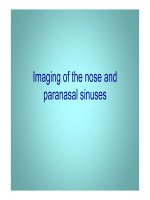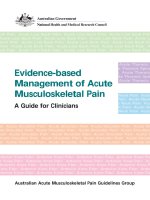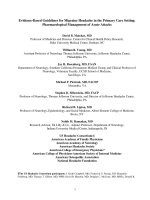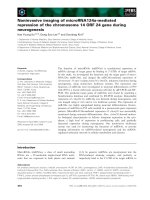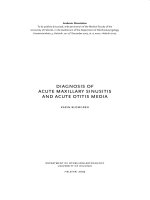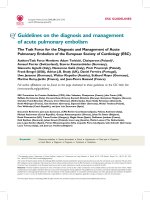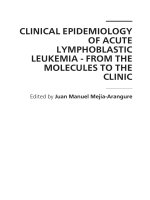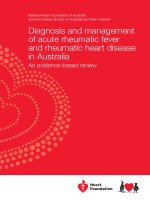CT imaging of acute pancreatitis
Bạn đang xem bản rút gọn của tài liệu. Xem và tải ngay bản đầy đủ của tài liệu tại đây (3.86 MB, 51 trang )
CT Imaging of Acute
Pancreatitis
Erin Rikard
Radiology
December 2007
Outline
•
•
•
•
•
Definition
Epidemiology
Causal Factors
Pathophysiology
CT Evaluation and Findings – Normal and
abnormal
• Complications
• Management
• Prognosis
Definition
Definition
Ac
Pa ute
n
Inf crea
l am t i t
pa
i
sm
nc
a
rea tion
po
t en
s w of
co
mp tial f ith
let or
eh
ea
ling
Epidemiology
Epidemiology
•
79.8/100,000 per year → 185,000 new cases annually in U.S.
•
Peak incidence in 6th decade
Causal Factors
Causal Factors
Etiology
Incidence
Cholelithiasis
30-60%
Alcohol
15-30%
Iatrogenic
2-5%
Trauma/Surgery
--
Metabolic Disorders
--
Viral Infection
--
Pathophysiology
Pathophysiology
•
Pancreatic autodigestion, with activated pancreatic enzymes
escaping the ductal system and lysing tissue of pancreas and
adjacent structures
•
Lack of capsule facilitates spread
Normal CT
Findings
Normal Anatomy by CT
• Pancreas arcing
anteriorly over spine
• Head adjacent to
duodenum
• Tail extending toward
spleen
• Splenic vein posterior
to body and tail
• Portal vein confluence
immediately posterior &
left of pancreatic neck
Normal Morphology by CT
• Pancreatic acini → lobulated contour
• No capsule
• AP dimensions
Head 2-2.5 cm
Body and tail 1-2 cm
• Pancreatic duct
Maximal diameter 3 mm in adults (5 mm in elderly)
Empties into ampulla of Vater, along medial aspect
of 2nd portion of duodenum
50 year-old woman
A
CT scans of normal kidneys and pancreas
Bennett, W. F. et al. Am. J. Roentgenol. 2000;175:882-883
V
Copyright © 2007 by the American Roentgen Ray Society
Spleen
L
Kidney
R
Kidney
ea
s
Liver
cr
Pa
n
Stomach
Evaluation by CT
Evaluation of Acute Pancreatitis
•
Contrast-enhanced CT is imaging modality of choice
•
Oral and IV contrast differentiate pancreatic tissue from
adjacent blood vessels and duodenum
Recommendations for ContrastEnhanced CT
•
•
•
•
•
Clinical diagnosis in doubt
Severe clinical pancreatitis
Ranson score > 3
APACHE score > 8
Failure to rapidly improve within 72 hours
of beginning conservative medical therapy
• Initial improvement with later deterioration
Ranson Criteria
At admission
•
•
•
•
•
Age > 55
WBC > 16,000
Blood glucose > 200
Serum AST > 250
Serum LDH > 350
After 48 hours
• Hematocrit ↓ > 10%
• ↑ BUN ≥ 1.8 after
rehydration
• Serum calcium < 8.0
• PO2 < 60
• Base deficit > 4
• Estimated fluid
sequestration > 6L
Abnormal CT
Findings
Abnormal CT Findings
•
Peripancreatic inflammation
•
Diffuse or focal pancreatic edema
•
Poor definition and heterogeneity of gland
•
Fluid collections
•
Necrosis
•
Thickening of pararenal fascia
Spectrum of Disease
• Mild Cases
May be normal or
show only mild gland
enlargement
• Severe Cases
May reveal
peripancreatic fluid
&/or pancreatic
necrosis and
phlegmon
Peripancreatic
Inflammation/ Pancreatic
Edema/
Fluid Collections
Gallstone-induced pancreatitis in 27 year-old woman
Balthazar, Emil J. Radiology. 2002; 223: 603-613
Copyright © 2002 by RSNA
Transverse CT scan obtained with intravenous and oral contrast material reveals a
large, edematous, homogeneously attenuating (73-HU) pancreas (1) and
peripancreatic inflammatory changes (white arrows). Although the attenuation
values are low, there is no pancreatic necrosis. Calcified gallstones are seen in
gallbladder (black arrow). 2 = liver (140 HU).
Infection?
•
Gallium-67 SPECT (perfusion studies)
•
? with (+) findings had infection at intervention – 78% of all
patients
•
No false (+)
•
No correlation between gallium uptake and presence or
absence of necrosis
47-year-old man with severe pancreatitis
West, J. H. et al. Am. J. Roentgenol. 2002;178:841-846
Copyright © 2007 by the American Roentgen Ray Society
Fluid collection replacing pancreatic body and tail
